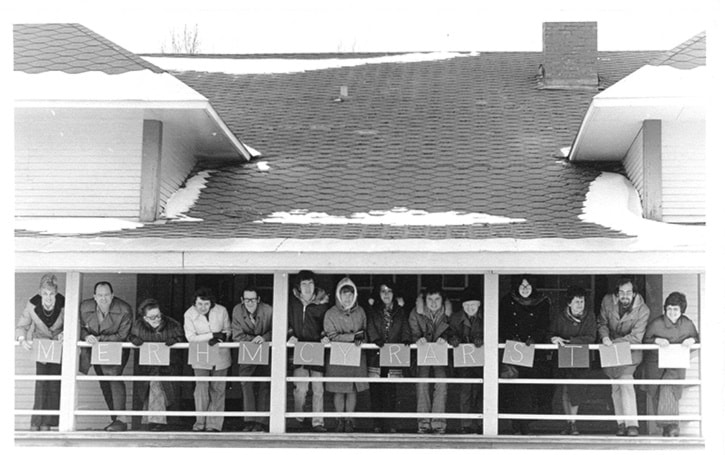By Kelsey Wiebe
George Little, an early settler who claimed the tract of land that became downtown Terrace, was well known in the early and mid-20th century for planting hundreds of trees around the community.
Several of those trees are still standing, including a few red sugar maples in the Kitsumgallum Cemetery at the crest of the bench near Northwest Community College and on the 4600-block of Lakelse Avenue.
Pat Beaton, a colourful Irish emigrant whose stories in our archive includes being a bodyguard for the King of Spain, remembered Little planting a row of evergreen trees along a fence on Keith Ave.
In December, Terrace residents lopped the tops of the trees off and brought them back to their living rooms to serve as Christmas trees.
In an isolated northern community, mail was often of critical importance in the Christmas season. Steve Tomecek recalled travelling from Rosswood to Terrace just before Christmas to pick up Christmas letters and parcels. After that, they wouldn’t get any mail again until the spring.
George Spencer, who lived in Aiyansh, used to get mail by dogsled in the winter, once every month.
“Christmas mail was the biggest load,” he told interviewers in 1978.
“I remember lots of times there was 100 to 120 bags. Lots of times the river would freeze so it would be part open and part froze and [mail carriers] would have to take the canoe on the sled and take it over the ice and dump it back in the water again. Sometimes it would take them pretty near a month to bring that mail up.”
In Terrace, mail delivery was much simpler, though it still required great effort.
Sam and Lee Kirkaldy “used to give really good service, I can remember,” Lorraine Johnstone stated in a 1978 interview. “For instance, on Christmas Eve, if the train was late or something and parcels came in, they would always sort that Christmas mail. If somebody wasn’t there to pick up their parcel, then they would deliver it to them. That’s how small Terrace was.”
Emil Jopp remembered a cooperative, celebratory spirit in Terrace in the 1910s and 1920s.
“We, the whole people, got together in the Farmers’ Institute. We belonged to it and everybody chipped in for a few dollars and bought a phonograph.” This allowed for Christmas-time dances.
Belle Watt (nee Frank) wrote poems about Terrace, including ‘Old Timer’s Christmas,’ which was published in Happy Times in Rhyme.
“Our Christmas concert was the grandest thing,” she reminisced, many years later.
“We’d recite, put on plays, dance and sing. Our teachers were marvels, everyone agreed. The costumes and stage settings were wonders indeed.”
Christmas was, of course, not the same for everyone who lived in the community.
Pat Beaton remembered in 1978 how annoying Christmastime was, because of all the do-gooders who wanted to include bachelors like him in the holiday cheer.
The wife of the man who ran the Terrace Hotel had a Christmas banquet for bachelors and old-timers, featuring her homemade wine.
Beaton and his bachelor friend Charley Burkewhistle were strong-armed into going one year and Beaton remembers not being able to eat in peace.
The women “would put a chunk of turkey and a couple of vegetable on a plate and this one would come along – ‘Oh you should try some of this’, and another come along, – ‘I know you would like some of this.’ And they wouldn’t let you go ahead and eat it. Trying to be helpful, you see. If they just sit down and behaved themselves and if there was something we would like we would ask for it. Charley and me, we looked like we would ask for it.”
“Charley and me, we looked at each other and started for the door and one preacher came down to the door – ‘What’s the matter?’ I said, ‘If it is so good, eat it yourself.’ That’s why I don’t go to these kinds of things.”
More seriously, Christmas for First Nations people was not always a celebration. Well into the 20th century, First Nations people were not allowed in any place serving liquor. They were also banned from sundry other restaurants and stores, due to prevailing notions of race. Addie Turner (nee Nelson) recalled in a 2004 oral history that her family was never invited to the staff Christmas parties for the sawmill where her father worked because there would be alcohol there.
Through the paternalistic laws of the Indian Act, it was illegal to sell or give liquor to First Nations people from 1876 to 1970.
Christmas tends to be a season of community and celebration, so we see the makeup of our early community reflected through the memories of Christmas.
How, though, did Terrace residents who were Jewish, atheist, or Sikh – so, who traditionally did not celebrate the holiday – look upon Christmas celebrations?
In what other ways did people celebrate? The preservation of voices other than those of the predominantly European pioneers is one of the major gaps in the museum’s collection, and is something we have been working to correct through oral history projects.
Kelsey Wiebe is the curator of the Heritage Park Museum in Terrace, B.C.
